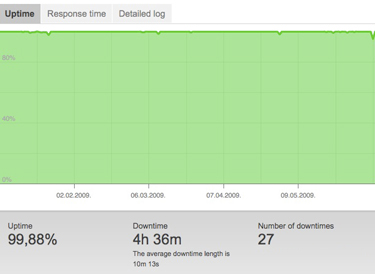
Network uptime is one of the most important metrics from the perspective of administrators. Network uptime is a measure of how much time an IT system, hardware or a specific device is working successfully. Downtime, in simplest terms, is when a system isn’t working.
When it comes to businesses that rely primarily on their own hardware and network components, it’s almost fully up to them as to the steps they take to increase uptime and reduce downtime. However, with an increasing number of cloud computing components being introduced into networks, it adds another level to the discussion of uptime versus downtime, since businesses have to work to find vendors that deliver on the uptime they promise.
The following explores more about the importance of uptime, and tips for increasing network uptime through options such as network automation and other strategies.
How is Uptime Measured?

Network uptime: what does it really mean?
There are some variances in how administrators measure uptime. One way it’s often measured is by looking at the amount of consecutive operational time. So, as an example, if a network was successfully operating for a month, four weeks could be the uptime at that moment.
When there is downtime, it’s usually up to the network administrator to identify why and provide a description of what occurred leading to that downtime. Sometimes downtime is planned, although many times it’s the result of errors.
Network Automation

Network Automation Market in Cloud network segment to observe 31%+ gains to 2024
When it comes to improving uptime and reducing downtime, one option available to administrators is network automation. Network automation allows for improved and centralized visibility and management, as well as integrated, consolidated reporting. Network automation can help reduce inefficiency and reduce costs, while also working on eliminating many of the most common manual errors leading to downtime.
Specific benefits of network automation include:
- The elimination of manual and human errors that are otherwise entirely preventable.
- Faster deployment because of the organized and centralized control over the network offered by network automation.
- The ability to identify unused IP addresses so that new devices don’t have to be purchased.
- With network automation, troubleshooting time can often be significantly reduced thanks to enhanced real-time visibility.
- Improved efficiency and workflows with role-based delegation.
How to Identify Network Health

Improving the Performance and Uptime of HPC Clusters
Something important to keep in mind as far as improving uptime is that there needs to be a streamlined way to gauge the health of a network at any given time. The importance of being able to see a full picture of network health goes back to the benefits of network automation. Many organizations face silos that prevent them from getting a full picture without automation.
To gauge network health, it’s a good idea to have an outline of all assets and services that are part of a network, as well as information such as the vendors involved with each aspect, how they connect to one another, and how the specific assets affect the overall network.
Understanding the Costs of An Outage

Analytics are the key to network uptime, but are they enough?
It’s important to have a view and a realistic perspective of how much an outage can cost an organization because this helps you better come to terms with how much you should invest in preventing outages as much as possible.
A few examples of the costs of an outage based on research include the following:
- According to a study from IHS released in 2015, losing system availability costs enterprise-level organizations an estimated $700 billion each year.
- Estimates from Gartner show that businesses lose an average of $300,000 per hour of downtime.
- The average cost of an hour of downtime has risen by anywhere from 25 to 30 percent over recent years.
The more high-level transactions a business does, the more likely downtime is going to cost them significantly.
Small Business Tips

Increase Uptime in Your Data Center Network
Small businesses are affected by downtime as much as larger businesses, although the financial costs might not be as high.
Small businesses who want to reduce downtime should first ensure they have the fastest internet connectivity they can purchase and afford. They should also choose a corporate-level router which is designed for the specific needs of businesses. A corporate-level router offers not only greater reliability, but also improved security and more scalability.
Small businesses should also have a redundant connection, and they should have a plan in place for how downtime is handled. This includes identifying the downtime and the causes, how it will be addressed, and what happens in the interim to reduce lost productivity and expenses as much as possible. It’s important for a small business to have a plan to keep things moving in an outage.




